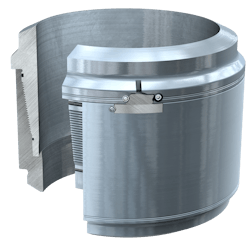Hands-free, self-installing specialty connector saves time, improves safety
Conventional casing connectors and traditional installation methods are employed offshore every day, but with the industry struggling to lower opex costs and reduce HSE risk exposure in increasingly complex environments, long-established approaches need to be reevaluated. The fact is that applying the same thinking and using the same types of components cannot deliver substantive improvements.
The need for reliability in more and more exacting operating environments has led to changes in industry connector standards and customer demands, but even the most stringent qualification requirements in existence today do not reflect the high-pressure/high-temperature conditions these components often experience when they are deployed. To provide connectors that can contend reliably in extreme conditions, it is necessary to set the performance bar higher.
Designing for critical service
In designing the BADGeR specialty casing connector, Dril-Quip engineers realized that if they intended to deliver better performance that would reduce HSE risk exposure and reduce opex, they would have to take a completely new approach that eliminated the shortcomings of current designs. That meant taking a step back.
Instead of looking at ways to make current designs better, they started over with a blank sheet of paper, considering the limitations of existing connectors and thinking about how functionality and safety could be improved by eliminating components and simplifying installation. The goal was twofold – to build the most robust connector possible and to make it easy to install to deliver permanent cost savings.
Thinking outside the box
One of the first areas targeted for improvement was the sealing mechanism. The team ruled out using O-rings as a primary seal to eliminate the common issues of degradation and gas decompression and focused instead on improving the sealing capacity of the connector’s metal-to-metal seals.
Multiple designs were developed and tested before the team found a way to fabricate a seal that does not experience degraded integrity under high levels of tension and compression. The unique metal-to-metal sealing system improves under tension and is optimized for fatigue, delivering a gas-tight seal that can be used on large-diameter tubulars in a range of applications. The metal-to-metal primary seal is coupled with an elastomer secondary seal to provide dependable pressure containment for critical service.
The newly introduced connector also reduces risk with the integration of a unique hands-free anti-rotation device that allows the connector to make up automatically, eliminating the need for personnel in the red zone and preventing potential damages from dropped objects, missing components, damage to keys or injuries to personnel. Unlike conventional connectors, which must be installed by one to two crew members located in the red zone, the BADGeR connector’s unique anti-rotation device is preinstalled offline allowing for reduced HSE risk exposure while also reducing opex and installation time.
The anti-rotation keys and the self-aligning profile not only eliminate cross-threading and simplify connector placement, but they also reduce installation time. Using this novel connector saves 2 to 10 minutes per connector installed. Calculating savings based on 100-150 joints on each 22-in. casing joint, using this connector can reduce costs by $80,000 to $100,000 per well.
Testing to extremes
The connector underwent rigorous testing in house to API 5C5 CAL 1/ISO 13679 CAL 1-E criteria using high-pressure gas, with Lloyd’s Register providing third-party verification. Technicians tested a 22.5 in. x 2.25 in. BADGeR connector for tensile strength, compression strength and bending capacity at an internal pressure of more than 16,000 psi with zero leakage.
Fatigue testing was performed following DNV RP C203 guidelines on six full-size samples. The tests exposed the connector to 40 million cycles at alternating stress from 15ksi to 22.5ksi. During three of the tests, the failures that halted testing occurred not in the connector but in the pipe body. Two other tests were discontinued after millions of cycles with no damage to the connector. In only one test were technicians able to cause the connector to fail. The test results for the six samples yielded a stress amplification factor (SAF) of 1.04, the lowest recorded for any connector in the industry.
